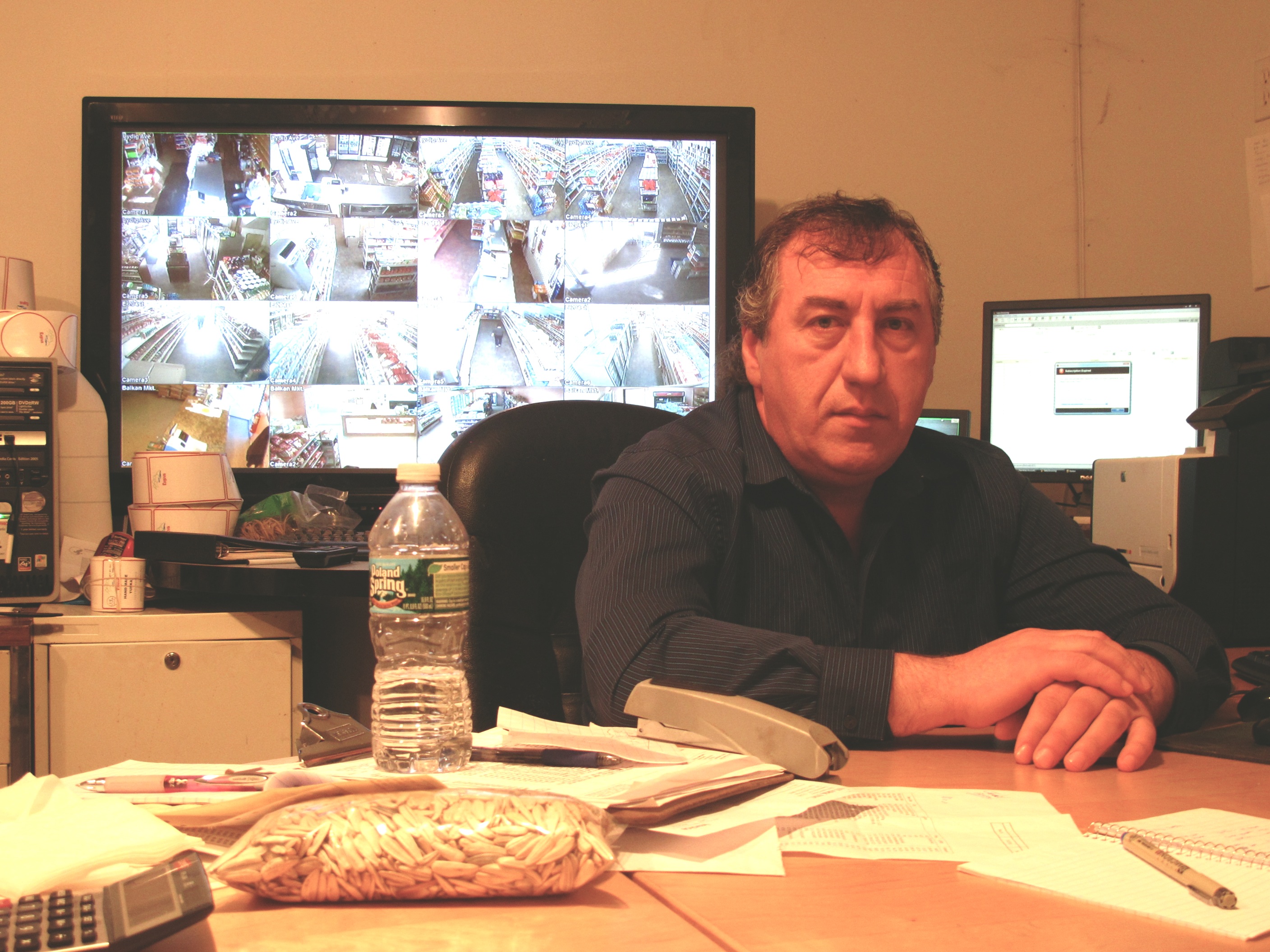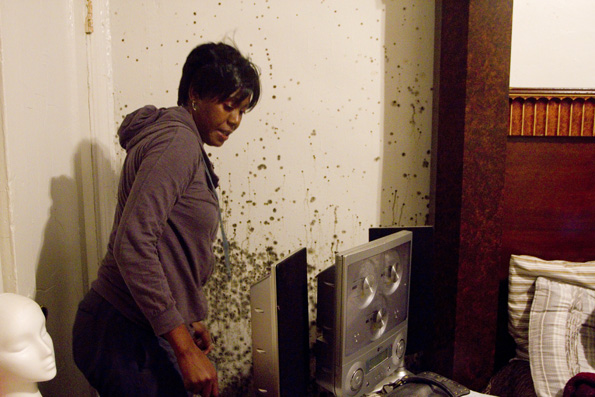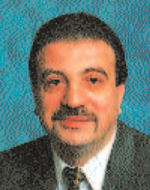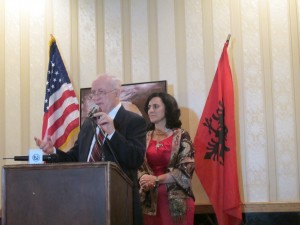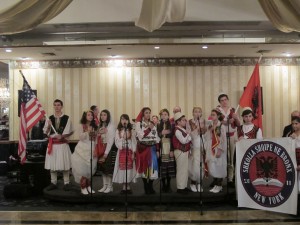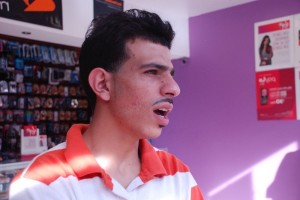img_6934_0
In 1984, after decades under the iron-fisted Yugoslavia regime, Mustaf “Mujo” Rugova, an ethnic Albanian from a small village in Montenegro, escaped the tumult of ethnic persecution to join what became the mass Albanian exodus.
On the way to America, he was caught and detained while illegally crossing the Mexican border. “It took me 30 days from my village of Plav to the Bronx,” said Rugova, 47, from his warehouse office on Merritt Avenue, giving his back to a huge plasma monitor capturing live surveillance images from all his stores in the Bronx.
Rugova today is one of the biggest importers of European products in New York City. His L&M European market has expanded in the last eight years into three branches on 204th street, Arthur Avenue of Little Italy, and Lydig Avenue–all in the Bronx.
His markets contribute to the thriving presence of Albanian immigrant businessmen in the Bronx. Many have converted Lydig Avenue into what is now known as “Little Albania.” The block is an eclectic blend of Albanian pizzerias and bakeries, kosher Russian butchers, and small European markets, providing staples for the sizable Albanian and eastern European communities in New York City.
“It took years of dedication and hard work to gradually move up from the bottom,” said Rugova, as he supervised a large cheese delivery from Bulgaria arriving at his warehouse.
Products such as Bulgarian cheese, Albanian sujuk, hot banana peppers from Macedonia, and Rugova’s brand jars can be found on his shops’ shelves. “This is the forefront of all European markets in the Bronx,” said Rugova’s wife, Linda, who manages the Lydig Avenue branch.
He began work as an assistant plumber, making just $5 a day, and faced many hardships before opening his first grocery shop on Pelham Parkway in 2003.
Rugova is part of the second wave of ethnic Albanian immigrants to the Bronx. The first wave arrived in the late 1960s and the early 1970s, filling the vacuum left by Italian families on Pelham Parkway and around Morris Park and Arthur Avenue. Those nationalities were leaving in droves to the suburbs. The area is now home to the most populous Albanian community in the country.
These immigrants started off in low skilled positions in restaurants, grocery stores and building maintenance. Using a combination of business acumen and a strong work ethic, many gradually moved on from renters to becoming owners of the building.
George Dedvukaj, 58, a Catholic Albanian immigrant from Montenegro, and the owner of Giovanni’s Pizzeria, is one example.
Dedvukaj, who immigrated in 1970, after spending 18 months in Italy, is a quirky self-made, and highly esteemed entrepreneur. He worked in Italian-owned pizzerias in the Bronx for 26 years before acquiring his own restaurant.
Since 1996, Dedvukaj and his family have run Giovanni’s Italian restaurant on Arthur Avenue, a landmark address in the Bronx.
“I bought it from its Italian owners, who had to give up their store and move upstate,” said Dedvukaj.
As the neighborhood changed from a solidly Italian enclave, to a mixture of Italians, Eastern European and Latin Americans, Dedvukaj said his clientele has changed as well.
“As we have grown roots, our clients have changed to reflect all backgrounds. They come here for the signature pizza I personally make,” Dedvukaj said, flipping pizza dough in Giovanni’s kitchen, something he said he has passionately done for the last 15 years.
Ismer Mjeku, 50, publisher of the Albanian Yellow Pages, said that the tendency of Albanians to settle in Italian-domain areas was not coincidental, but rather the result of the strong historical ties between the two people. The majority of early Albanian immigrants had to seek temporary asylum in Italy before they could reach the shores of America.
“We are like brothers with Italians,” Mjeku said. “There is even a mixed-blood group called the Albanian-Italians, Arbëresh, in the south of Italy.”
Albanians running Italian restaurants in the Bronx often face scorn from clients for “imitating” the Italian recipes. Rugova, who co-owns Portofino with his brother Mario, said he regularly encounters animosity.
“You want real Italian food?” he once told an Italian-American senior citizen, “then you should call your travel agent and fly to Napoli or Sicily.”
Rugova, a burly chain smoker with long, unkempt hair and a raspy voice, explained this phenomenon as a shift of power within the Bronx decades ago when it began to lose its luster to many of the newer generations of Jewish and Italian families.
“We used to take the working day jobs in those restaurants under its authentic Italian management, and now we own them,” Rugova said. “Now the Mexicans and the Caribbeans are doing these jobs for us, and who knows? Maybe they will become the next owners of the Italian restaurants in the Bronx.”

After escaping years of economic setbacks and ethnic persecution back home, Albanians are thriving in the Bronx. (MAHMOUD SABBAGH/The Bronx Ink)
Albanian affluence follows in the footsteps of other immigrant groups.
Mjeku who has been the publisher of the Albanian Yellow Pages for 15 years, estimated the size of the Albanian community in New York at roughly between 175,000 and 200,000. “We have 40,000 listed phone numbers in our white pages. If we estimated five family members for each phone, that’s almost 200,000,” he said.
He estimated that two-thirds of the Albanian community in New York is located in the Bronx itself.
Mjeku’s annually updated book compiles lists of all personal contacts, businesses and real estate holdings of Albanians in the country. “I am more efficient than the government data,” he said.
Albanians have followed the real estate business model previously developed by Jewish immigrants in the borough. They have bought up property in less expensive areas en masse and now lay claim to, by some estimates, one-third of all apartment buildings in the Bronx, according to Mjeku.
Major Albanian landlords took over rental apartments during the 1973 apartment-building crisis in the Bronx, said Mjeku, who was about to publish a new book entitled “One Life Between Kosovo and United States,” a story of Harry Bajraktari, a prominent Albanian real estate mogul with hundreds of apartment units in his portfolio.
Although the majority of the Albanians in the Bronx come from the middle class, more successful families have embraced their newfound prosperity and began moving out of the Bronx for the wealthier suburbs in Westchester County. Some began assuming more institutional organization roles in their communities, even running for political office.
Albanian Americans span the political spectrum, their votes historically determined not by party but by a candidate’s foreign policy towards their homeland.
“Many Albanian Americans voted for Clinton in his first tenure,” said Mjeku. “But returned and voted overwhelmingly against him during his second tenure.”
This was due the entrance of Bob Dole, in the 1996 presidential race. He was a very close friend with the Albanian community and promised to support Kosovo independence.
Seizing on the interest, the Albanian American Civic League – an effective lobbing group in Washington for social and political interests – was founded by Joseph J. DioGuardi, a Catholic Arbëresh native, who once served as a Congressman for the 20th District of New York.
“Lobbying on homeland freedom, I contributed lots of money to the freedom of Kosovo,” Rugova said.
Mjeku, a congenial businessman who appears almost excessively well groomed, is a community leader himself who tries to bring Albanians of all faiths together.
“Motherland is what matters to Albanians, whether you are a Muslim, a Catholic, or an Orthodox Christian,” Mjeku said.
Dalip Greca, 50, the editor of the Gazeta Dielli, or in English, “The Sun” paper–the oldest Albanian newspaper in the world since 1909–mirrors Mjeku’s sentiments. “Albanian nationalism comes first to us, then religion follows,” he said, pointing to a two black and white portrays on the wall of his office on Southern Blvd.
Greca, who has a slight build and cherubic features, immigrated to America in 2000, pointed to the photos of the two founders of VATRA organization; the PanAlbanian Federation of America, which funds the Gazeta Dielli paper. In Greca’s interpretation, it represents the ultimate Albanian integration.
VATRA was founded in April 1912 by two pioneer Albanian immigrants – Fan S. Noli, a Catholic Bishop and FaikKonitza, a Muslim scholar. They both attended Harvard University before establishing VATRA to promote a unifying national spirit among their compatriots.
“We are older than the independence of Albania itself,” said Dr. GjonBucaj, director of VATRA, a respectable physician, who has been VATRA’s director since 1999.
The Republic of Albania declared its independence from the Ottoman Empire in Nov. 28, 1912, but native Albanians were still scattered across other neighboring countries such as Montenegro, Kosovo, and Macedonia.
For generations, Albanian immigrants in the Bronx have aimed to fully assimilate their children into the cultural and social norms of American society. They all go to local public schools, though some community programs provide Albanian language lessons for them on weekends.
The “ShkollaShqipe Ne Bronx,” or in English, the Albanian-American school in the Bronx, is a nonprofit school funded by local families. “Tuition is only $120 per term, and we only operate on Saturday and Sunday for three hours,” said Dedvukaj, who besides running Giovanni’s restaurant is also the supervisor of the school.
Mjeku’s children have been attending this school in the weekend. “My two children will pursue law and medicine majors later in college,” he said with assertion.
“We are fed up with warfare business,” said Rugova, pointing towards a photo of his 90-year-old grandfather on his office wall. “My grandfather’s traditional turban was his shroud. Every man had to wear his own death cover in my village.”
Rugova had to leave school in fourth grade because he was not able to study what he wanted to under the Communist rule. He said all he wants is for his three sons and daughter – all of whom are in college or high school- to integrate and accept others.
The Catholic Albanian Church in the Bronx – “Zoja e Shkodres,” – plays a distinct community role and does not descrimante on the basis of faith. “We all attend the Catholic Church for events regardless of our faith,” said Mjeku, who is Muslim by birth, yet hangs a poster of Nene Terezes, the Albanian sister, formally known as Mother Teresa, on his modern office overlooking Arthur Avenue.
Mjeku is the director of the annual Albanian-American Festival in the Bronx, “FestivaliShaqiptar,” which is the biggest cultural Albanian event in America.
Celebrated annually in November, thousands gather for Albanian Folk music and dance. The festival recently celebrated its 21st anniversary at Lehman College.
Mjeku pointed out that among the festival’s organizing community were Albanians from all religions.
“The festival is presented by The Mother Teresa Center of Our Lady of Shkodra Roman Catholic Church, and a Fustanella performing group from Boston with a Sufi influence won the contest,” Mjeku said.
Albanians in New York City enjoy many community amenities and organizations that are lacking in other places. However, they still express their desire for an Albanian house that would unify the community under one roof.
“We lack an Albanian cultural center,” said Mjeku, suggesting that there might be an ongoing Manhattan-based plan in the pipeline.
Mjeku, who is inspired by the Jewish community in New York, in their institutional organization efforts, even saw a blue-print for his own Yellow Pages business in the old Jewish Yellow Pages years ago. The guide has since been sold to publishing conglomerate, Verizon, in a lucrative deal.
Asked whether he would sell his Albanian yellow pages if he received a similar deal?
“Of course I will do,” Mjeku promptly said. “As long as it helps to continue the thriving of the Albanian community.”
Albanian-owned businesses on Lydig Avenue:


